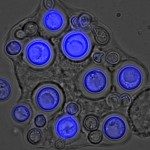Link to Pubmed [PMID] – 21741999
J. Microbiol. Methods 2011 Sep;86(3):357-63
Genetic studies of the protozoan parasite Toxoplasma gondii have identified three main distinct types according to virulence in some hosts. Several methods have been developed to differentiate genotypes currently dominated by microsatellite markers targeting single-copy loci. We analyzed the possibility of using the 35-fold repetitive B1 gene via high-resolution melting (HRM) curve analysis. Sequencing of the B1 gene of 14 reference strains (four Type I, six Type II, and four Type III strains) identified 18 single nucleotide polymorphisms (SNP). Primers were designed to amplify eight of them for HRM analysis and for relative quantification of each nucleotide variation using SNaPshot mini-sequencing. Genotyping with five microsatellite markers was performed for comparison. Two to four HRM profiles were obtained depending on the SNP tested. The differences observed relied on the different ratios of nucleotides at the SNP locus as evidenced via SNaPshot mini-sequencing. The three main lineages could be distinguished by using several HRM profiles. Some HRM profiles proved more informative than the analysis based on five microsatellite markers, showing additional differences in Type I and Type II strains. Using HRM analysis, we obtained at least an equally good discrimination of the main lineages than that based on five microsatellite markers.

